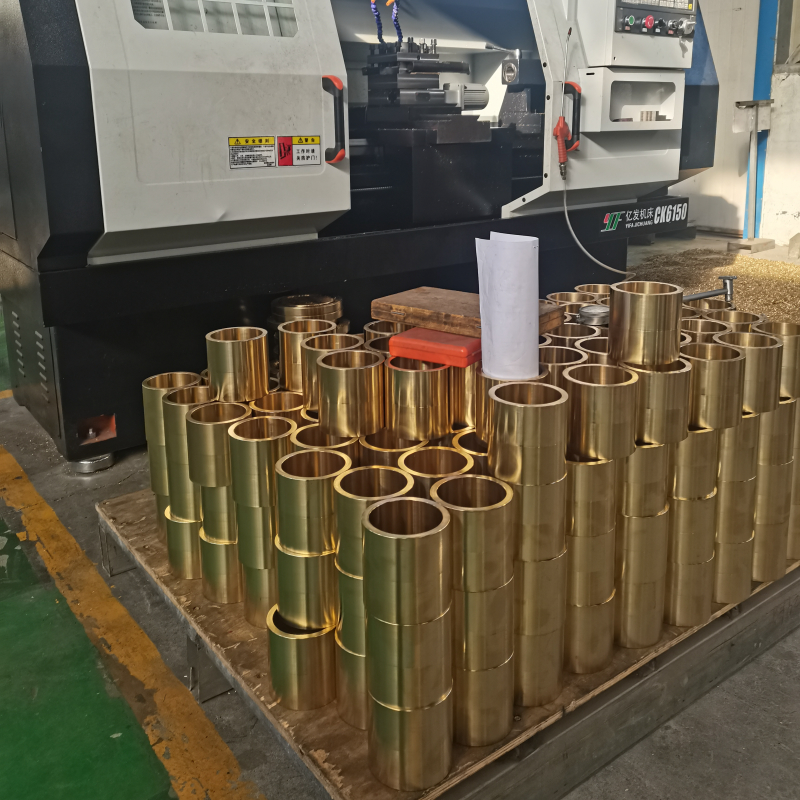 Mazhuang Village, Yuhe Town, Huixian City, Xinxiang City, Henan Province, China
Mazhuang Village, Yuhe Town, Huixian City, Xinxiang City, Henan Province, China
 Service Hotline +86 17630258963
Service Hotline +86 17630258963  Cell phone +86 17630258963
Cell phone +86 17630258963 The coefficient of friction of copper sleeve has a close relationship with the temperature, which is mainly manifested in the following aspects:
Lubricant performance changes:
As the temperature rises, the viscosity of the lubricant used in the copper sleeve will usually be reduced. Low viscosity lubricant is easier to form a thin and uniform oil film between the copper sleeve and the matching parts.
A good oil film reduces the chance of direct contact between metal surfaces, which reduces friction and results in a lower coefficient of friction. For example, at low temperatures, when the viscosity of the lubricant is high, the coefficient of friction may be about 0.2; when the temperature rises to a certain level, the viscosity of the lubricant decreases, and the coefficient of friction may drop to about 0.15.
Thermal expansion of materials:
Elevated temperatures cause thermal expansion of copper sleeves and mating parts. Thermal expansion may result in a change in the mating gap, which may affect the coefficient of friction.
In some cases, proper thermal expansion can result in a tighter fit and increased oil film stability, which in turn can reduce the coefficient of friction. However, if thermal expansion is excessive, the gap may become too small, increasing friction and the coefficient of friction. For example, in a certain temperature range, the thermal expansion of the copper sleeve makes the fit clearance more reasonable, and the coefficient of friction decreases from 0.18 to 0.16; however, when the temperature continues to rise, the thermal expansion is excessive, and the coefficient of friction may rise again to 0.18 or even higher.
Surface oxidation and chemical reactions:
Higher temperatures may accelerate surface oxidation and chemical reactions with substances in the environment. In some cases, the oxidized layer or chemical reaction products may have a lubricating effect and reduce the coefficient of friction.
However, it is also possible that the oxidized layer or chemical reaction product formed is rough or highly frictional, thereby increasing the coefficient of friction. For example, in a particular temperature and environmental conditions, the copper sleeve surface formation of the oxide layer is relatively smooth, the coefficient of friction from 0.2 to 0.18; but in other cases, poor oxidation or chemical reaction may make the coefficient of friction rises to 0.22 or more.

Lubricant viscosity increases:
When the temperature decreases, the viscosity of the lubricant will increase. Higher viscosity lubricants become less fluid, making it difficult to form an effective oil film between the copper sleeve and the mating parts.
This results in increased direct contact between metal surfaces and increased friction, resulting in a higher coefficient of friction. For example, a copper sleeve with a coefficient of friction of 0.15 at high temperatures may have a coefficient of friction of about 0.2 when the temperature is lowered.
Material shrinkage:
Lower temperatures cause shrinkage of the copper sleeve and mating parts, which may result in an increase in the fit gap. The increased clearance reduces the stability of the fit, making it prone to wobble and instability during operation.
This instability increases the fluctuation of friction, which leads to a change in the average coefficient of friction. For example, if the temperature decreases so that the gap between the copper bushing and the mating parts increases from a few filaments to dozens of filaments, the coefficient of friction may increase from the relatively stable 0.16 to 0.18 or even higher, and the fluctuation amplitude will also increase.
Overall, the relationship between the coefficient of friction of the copper sleeve and the temperature is more complex, and is affected by a variety of factors. In practice, according to the specific working conditions and requirements, need to reasonably control the temperature, choose the right lubricant and copper sleeve material, to ensure that the copper sleeve in different temperatures can maintain a more stable and appropriate coefficient of friction.
